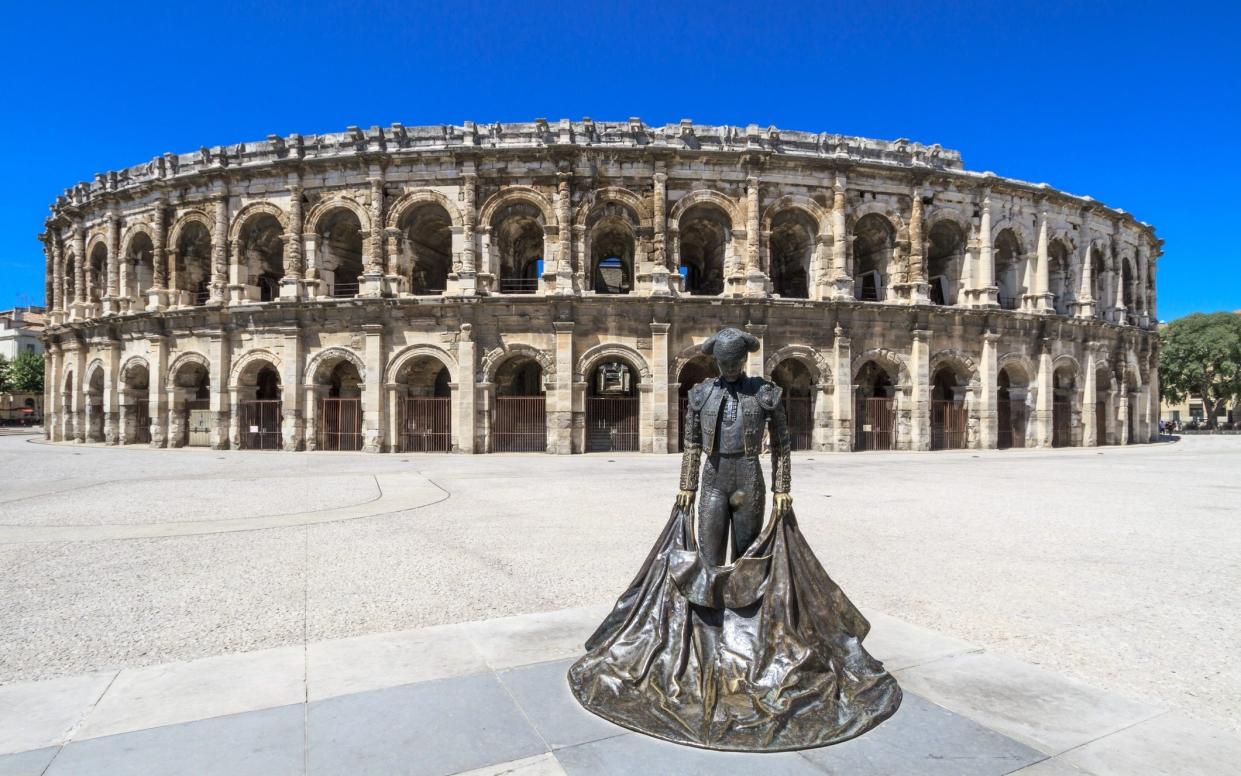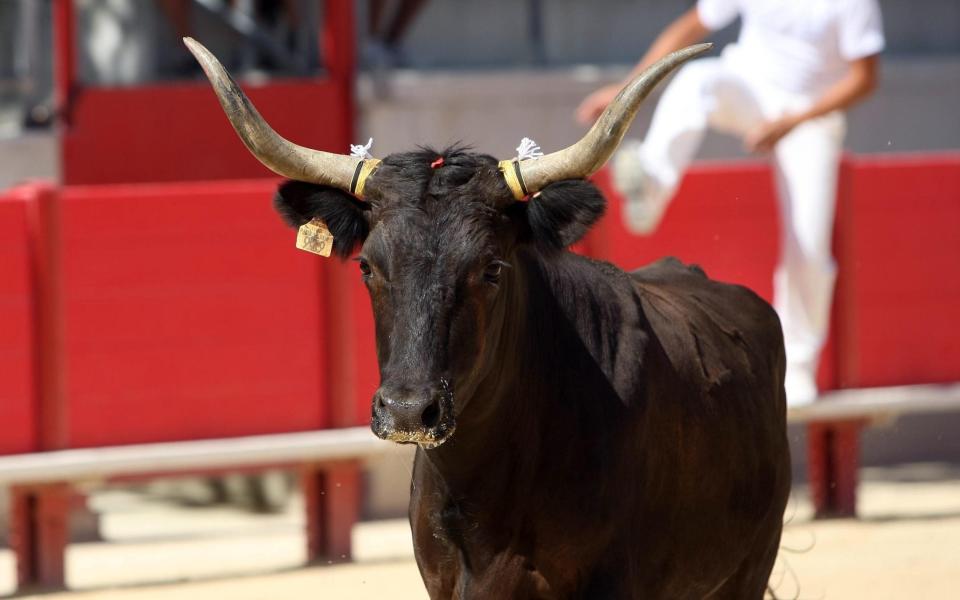Bullfighting is still big in the south of France, waiting to spoil a good holiday

France is once again agonising over bullfighting. Like Scottish independence, the banning of fox-hunting and the relegation of Morecambe FC in Britain, the issue never quite goes away – and then bursts through to the surface when you rather wished it wouldn’t. This time, TV journalist-cum-left-wing MP Aymeric Caron has brought before parliament a draft law banning all bullfighting, to be considered this week.
Caron reckons that the corrida is “an ignoble practice which dishonours us all”. He is not alone. A poll earlier this year suggested that 77 per cent of French people were opposed. They include Anouk Aimée, Alain Delon, Brigitte Bardot and Pamela Anderson, so Caron has the veteran good lookers on his side. Antis took to the streets in cities across France last weekend in support of the bill, expressing anger at what they reckon is a barbaric practice. Writer Christian Laborde suggested in Le Monde that “arenas are very noisy cemeteries”.
The demos were echoed by those of bullfight supporters – more numerous, it seems – decrying an attack on what is an essentially southern tradition by clueless Parisians. “The tauromachie (bull culture) is our identity, a living culture. Let us be free to live with our traditions,” said Julien Dubois, mayor of Dax – a bullfighting town if ever there was one. He could apparently call upon the support of the likes of Eric Cantona, Zinedine Zidane, and ex-French PMs Lionel Jospin, Alain Juppé and Jean Castex.
The pursuit arrived in France in the mid-19th century, as part of the baggage of the Empress Eugénie, Spanish wife of Napoleon III. It caught on especially down in the south, from Western Provence through to what’s now Occitanie and Nouvelle Aquitaine.
It is, in fact, legally confined to those regions, and not just anywhere in those regions, either. In order to put on a corrida, a town or village has further to demonstrate an “uninterrupted bullfighting tradition”. The thinking is that bullfighting is cruel – France’s penal code says as much – but they’ve been doing it for ever in the south, so let them get on with it. We’ll make an exception. Thus, right now, bullfighting is legal in Nîmes but not in nearby Montpellier (where there have been no bullfights for years), and even less so in, say, Lille in northern France.
I’m not a natural audience for bullfighting, as I'm not for bear-baiting, cock-fighting or heavyweight boxing. But I really fell out with the pursuit when, ages ago, I went to see Marie-Sara, then a blonde and extravagantly beautiful horseback bullfighter, or rejoneadora as they say in aficionado circles. (Not the least irritating aspect of French bullfighting is its exclusive use of Spanish.)
In the Roman arena in Nîmes, Marie-Sara – then the world’s most famous woman bullfighter – was squeezed into the tightest possible suit and handling her horse with bewitching skill and astonishing courage, first to taunt, then to despatch the bull. This was troubling on more levels than I could count. Later, however, I saw a couple of novilladas, combats in which aspiring bullfighters take on young bulls. At one, in Arles, the young fellow might as well have set about the bull with garden shears for all the artistry on display.

All the stuff I’d been hearing about the cultural complexity of the corrida, the bravura of bulls, the grace of bullfighters and the complicity of both in weaving another elegant strand in the age-old conflict between man and beast... well, all that stuff sounded a bit daft, if not insane, as a bloody corpse was dragged from the arena. Projecting human attributes – courage, nobility, bravura – onto a 1,200lb snorter may inspire fans but makes no kind of sense in the context of a cack-handed abattoir show. Or any toro show at all, really.
From Marie-Sara and, subsequently, many others, I’ve heard every pro-bullfighting argument without being unduly impressed. They run from the almost-acceptable – “without the corrida, fighting bulls wouldn’t exist as a breed” – to the frankly bonkers. The website of the Union of French Bullfighting Towns suggests that the corrida “symbolizes the elevation of man from a state of nature to a state of culture.”
Somewhere in between is the appeal to tradition. Except, as has often been said, if we’d stuck to tradition, we’d still be baiting bears, sending kids up chimneys and watching the Black And White Minstrel Show.
The trouble is that I live in the tauromachie heartland, near enough to Nîmes, Arles, and Béziers to hear an awful lot about bullfighting. Enthusiasm for the practice ripples out across the landscape. And, tragically, few locals are very interested in the opinion of some bloke from Lancashire. (I’ve even heard “You have cricket, we have bullfighting” without replying that, by and large, we don’t kill batsmen.) There are, after all, around 170 bullfights a year in France, generating some £35 million. That’s not counting the vaster sums of cash brought by tourists to events like the Féria de Nîmes. It’s reckoned that a million people show up for the town’s main, Whit weekend bullfight-driven party. That’s an estimated £56 million in the town’s coffers.
No wonder no-one’s listening to Lancashire. So it is fortunate that the tauromachie, or bull culture, around here isn’t limited to real Spanish-inspired bullfighting. There are two other elements which involve bulls but don’t kill them. These are the ideal option refuge for outsiders – whether residents or visitors – wishing to experience local life without witnessing ritual slaughter.
For a start, there’s the bull-running, or course camarguaise in and around the Rhône delta. Rather than the king-sized Spanish fighting bulls, the course camarguaise involves the smaller, fleeter Camargue items: these can turn on a two-euro coin. And – here’s the key difference – though they get annoyed, they never get stabbed to death.

Once the bulls are in the arena, fit young men in whites (like cricketers) race about, trying to grab baubles festooning the beasts’ horns and foreheads. After a 15-minute stint – which may be billed up to £2,500 – the bull is released and returns to roam the fields and marshes in the Camargue.
The spin-off of such arena events are the bull games at village festivals. Bulls career through narrow streets which, as village fête entertainment goes, is like being pinned down by festive machine-gun fire. The bulls undoubtedly have the upper hoof.
Meanwhile, over in Gascony, the course landaise involves equally fit young men essentially jumping over fighting cattle... usually, in this case, cows. Again, the animals leave the arena tired but alive.
But, while you could potentially experience these bull games as a tourist (as opposed to the corrida), you need to avoid getting carried away. Many locals don’t.
From the Camargue and Rhône river westwards, the activities are part of the warp and weft of life. People talk about them until you long to hit them with a skillet. Unless you’re born to it, the obsession may get overwhelming, like being cornered by baseball fanatics. But – here’s the thing from a tourist point of view – the associated activities are terrific. I cannot tell you what exhilaration I’ve had riding out across the Camargue on the white horses, with Camargue cowboys as companions, and semi-wild black bulls in the mid-distance. Similarly, the associated festivities – the barbecues, the steaks, wine and music – make southern nights worth living.
Oddly, the same is true of bullfighting itself. Whatever blood sport has been happening in the arena during, say, the Easter Feria at Arles or the Whitsun Feria at Nîmes (May 24-29, 2023), the streets beyond are throbbing with bodegas, crowds, dancing, drinking and more Latin life than many Latins can handle. I once had a goat fall into my lap from a step-ladder. Bullfighting may be the kicker, but you don’t have to take any notice of it. The electricity is available to all.
Would this festivity, though, exist without the bulls’ involvement? The antis say: “Of course”. I wonder. There’s a full-bloodedness to the frolics which may require a full-blooded focal point.
And, anyway, I doubt we’re going to find out any time soon. Aymeric Caron’s bill is likely to fail, not least because the government is against it. It will, I think, be as-you-were for the next few years.

 Yahoo News
Yahoo News 
